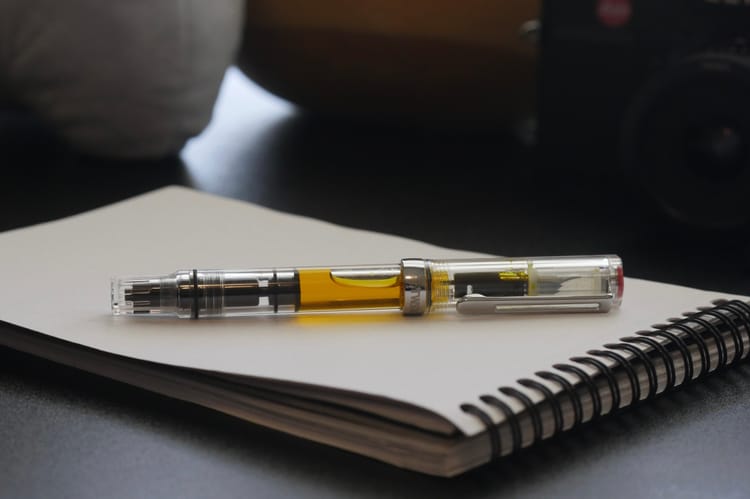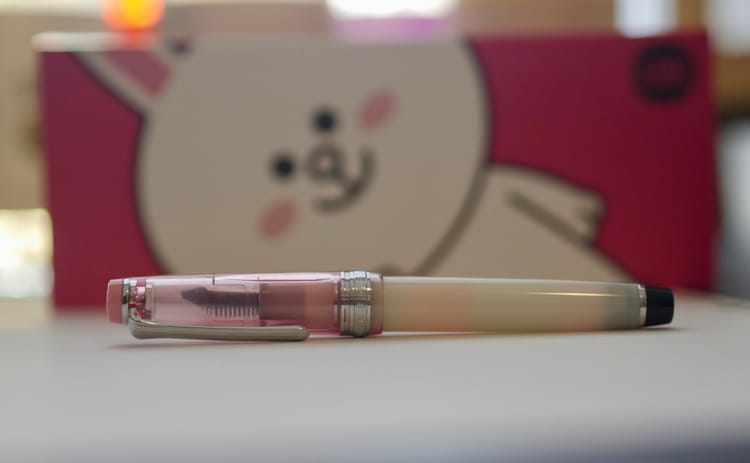Review: Opus 88 Demonstrator Fountain Pen

The Opus 88 Demonstrator is a fantastic pen from a lesser-known fountain pen maker: Opus 88. I've owned this fountain pen for over a year and still love using it.
This fountain pen features a pretty unique mechanism, especially at this low(er) price point. The Opus 88 Demonstrator is an eyedropper fountain pen that you can fill using the included eyedropper or, in fact, nearly any liquid-dropping tool. Unfortunately, over the year I've owned this pen, I've lost the included glass eyedropper, so I have to fill my pen with a syringe.
In an eyedropper fountain pen, the nib unit screws off to reveal a huge chamber that can be filled with ink. Compared to a traditional converter, eyedroppers tend to have significantly more space for ink, as more of the barrel space is used for ink. As the name implies, the Opus 88 Demonstrator is a demonstrator fountain pen, so you can easily see all the beautiful ink that lies inside the fountain pen.
The Demonstrator comes with a pretty standard Jowo #6 size nib. It's a nice, pretty large steel nib and writes reasonably well. Throughout the year I've owned this pen, I'd need to make slight readjustments to the nib (i.e. realigning it to the feed) to make it write smoothly. However, I haven't had any problems with the general usage of the fountain pen. And, if anything goes wrong, the Opus 88 Demonstrator can be fully disassembled, and you can even swap the nib with nearly every general Jowo #6 size nib unit. I haven't done this, so I can't comment on the experience, but I know it is possible to do it – you can even make your Demonstrator into a gold-nibbed fountain pen!

There are two ink reservoirs in the pen. A larger one that holds around a few milliliters work of ink and a smaller one that holds a little bit. The larger one makes up the body, and the smaller one feeds into the nib. During writing, the ink is drawn from the smaller reservoir and runs out after around a page of writing, in my experience. To refill the ink, simply unscrew the bottom piece to let more ink from the larger reservoir in. The mechanism makes it so that unscrewing lowers the blocker that separates the two reservoirs, allowing for free flow. Some people recommend leaving the reservoir open during longer writing sessions, but doing this results in a messy situation. The plastic feed gets filled up with ink and resultingly gets ink on everything.

In terms of looks, this fountain pen is one of the most aesthetically pleasing writing instruments I've owned. The nib has pretty scrollwork and is nice to look at, and complements the pen well. It writes with a slight flex if you try to push it, but I wouldn't recommend flexing this nib too much. My variant of the Demonstrator has white opaque ends and a translucent body with rainbow speckles throughout, which have some sparkles when hit by lighting.

The thing I appreciate about this pen is its ability to be nearly completely disassembled. You can access practically any part of the instrument and even unscrew the cap and take off the clip. I don't know why you would, but you can. The cap also features the only branding on the pen's body, reading Opus 88 in the brand's classic, elegant font.
A year later, this pen still holds up and looks as good as new. There even was a time when I was pretty rough with this pen, but there weren't any noticeable scratches unless the lights hit it at the right angle. This goes to show the excellent craftsmanship that went into making the pen.

The Opus 88 Demonstrator was my first "higher-end" fountain pen. I scooped it on sale at Endless Pens for less than $80. Even though I was lucky enough to secure this deal and didn't pay full price, I still think this pen is well worth its higher price tag of $125. Yes, It's a lot of money to pay for a steel-nibbed pen, but the build quality and unique eyedropper mechanism at this price point make up for that. If you're feeling particularly bourgeois, you can replace the nib unit with a third-party gold nib (that costs the same amount as this pen itself). There's a lot of flexibility with this pen, and that's the most attractive feature for me.
I will always have a soft spot for this fountain pen and thoroughly enjoy using it. I'I love the build of this pen as well. Compared to other higher-end pens I own, such as the Sailor Pro Gear or the Pilot Custom 743, I find the Opus 88 Demonstrator to be the highest value, which says a lot. The build quality is roughly the same as those two pens as well.






Comments ()